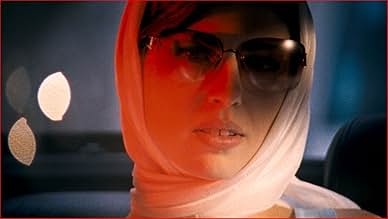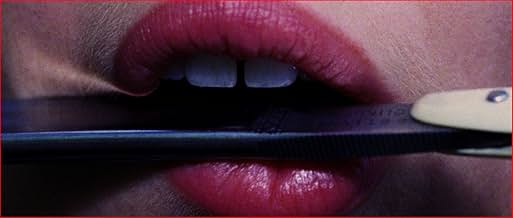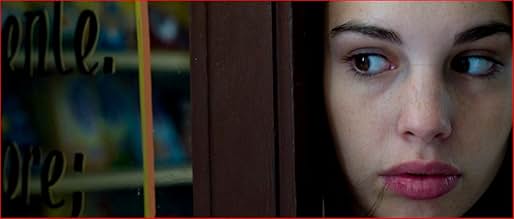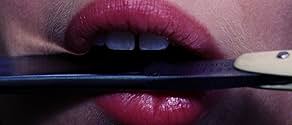AVALIAÇÃO DA IMDb
6,1/10
6,8 mil
SUA AVALIAÇÃO
Quando ela era uma criança, Anne era uma criança rebelde. Ela também foi atormentada por imagens de morte e uma figura escura e sinistra vestida de preto. Agora adulta, ela é mais uma vez at... Ler tudoQuando ela era uma criança, Anne era uma criança rebelde. Ela também foi atormentada por imagens de morte e uma figura escura e sinistra vestida de preto. Agora adulta, ela é mais uma vez atormentada por formas escuras e de outro mundo.Quando ela era uma criança, Anne era uma criança rebelde. Ela também foi atormentada por imagens de morte e uma figura escura e sinistra vestida de preto. Agora adulta, ela é mais uma vez atormentada por formas escuras e de outro mundo.
- Direção
- Roteiristas
- Artistas
- Prêmios
- 7 vitórias e 6 indicações no total
Charlotte Eugène Guibeaud
- Ana adolescente
- (as Charlotte Eugène Guibbaud)
Biancamaria D'Amato
- La mère
- (as Bianca Maria D'Amato)
- Direção
- Roteiristas
- Elenco e equipe completos
- Produção, bilheteria e muito mais no IMDbPro
Avaliações em destaque
Leaving viewers in the dark about the true inclination of a piece is commonplace in Art Cinema. I do agree that most mainstream films now are over explained and blatant with whatever plot device is being utilised. However, while i think it's good for the viewer to give a little of themselves to work at understanding a director's vision this was a little much.
The visuals are beautiful. Some of the little touches exquisite (the way the teenage Ana hypnotically chews on a strand of her hair was simultaneously abhorrent and alluring) I'm sure there is an intricate back-story here with allusions to Sigmund Freud etc (from what i've heard there is a portrait of him in the house, however i didn't see it) but i'm not hugely interested in discovering what it is. A little explanation can make all the difference. Some connection with the audience would have helped this piece along.
In the end, the plot made little difference. Its slightness WAS the film for me. I enjoyed the inspired jump-cuts and the obsession with body hair and sexual gratification. I was amused and disturbed. That's fine. But the film used these devices to the point of saturation. Overkill. Egotism.
I may be missing the point here, so be it. This film stands well as a piece of visual art. The vivid blue Mediterranean, the dark haired women, the gorgeous cinematography in general. But it is missing something as a film and thus with narrative. It would have worked FAR better as a short 15 minute piece.I would like to say i'd re-watch this and get to grips with what the director is trying to say, but that would be a lie. Certainly this film is nothing like the Giallo films of Fulci and Argento that i have seen so far in my admittedly limited viewing.
The visuals are beautiful. Some of the little touches exquisite (the way the teenage Ana hypnotically chews on a strand of her hair was simultaneously abhorrent and alluring) I'm sure there is an intricate back-story here with allusions to Sigmund Freud etc (from what i've heard there is a portrait of him in the house, however i didn't see it) but i'm not hugely interested in discovering what it is. A little explanation can make all the difference. Some connection with the audience would have helped this piece along.
In the end, the plot made little difference. Its slightness WAS the film for me. I enjoyed the inspired jump-cuts and the obsession with body hair and sexual gratification. I was amused and disturbed. That's fine. But the film used these devices to the point of saturation. Overkill. Egotism.
I may be missing the point here, so be it. This film stands well as a piece of visual art. The vivid blue Mediterranean, the dark haired women, the gorgeous cinematography in general. But it is missing something as a film and thus with narrative. It would have worked FAR better as a short 15 minute piece.I would like to say i'd re-watch this and get to grips with what the director is trying to say, but that would be a lie. Certainly this film is nothing like the Giallo films of Fulci and Argento that i have seen so far in my admittedly limited viewing.
The NY TIMES called AMER "an exercise in giallo (eroticized horror), a richly colorful mosaic of sinister sidelong glances" while the LA TIMES enthused, "a nightmare vision of desire and fear -gorgeous, heady, dazzling!" but these pointed paeans are only partly true. Except for the odd snippet, there's no dialog or musical score in the three vignettes depicting the life of a disturbed young woman (childhood, adolescence, adulthood) and although the last sequence contains elements of the giallo, the film is more of an homage to the indelible images of "maestro of the macabre" Mario Bava.
AMER's first segment on a child's reaction to her grandfather's death re-imagines the opening tale in Bava's trilogy I TRE VOLTE DELLA PAURA (aka BLACK SABBATH) from prying a valuable object out of a dead man's hand and the nightmare that follows right down to the dripping water and eerie blue, green, and red light that bathed the terrifying tableaux. The second segment on the girl's dangerous sexual awakening combines Bava's OPERAZIONE PAURA (aka KILL BABY KILL) and it's white soccer ball with the nebulous evil-under-the-sun aura of Tennesse Williams' SUDDENLY LAST SUMMER. The third and final scene that sees the young woman revisiting the abandoned villa where she grew up actually does reference BLOOD & BLACK LACE-style gialli with its black gloves, straight razor, and stalking sequence that leads up to a graphic murder. Unfortunately, there's only one (barely set piece) slaying in AMER and this dreamy collage of jump cuts, split screens, and undeniably beautiful imagery is less than the sum of its parts which may prove disappointing to hard-core horror fans. Cineastes -and those who enjoy avant-garde narrative as well as color-drenched kaleidoscopic visuals- should, however, get their money's worth. Hélène Cattet & Bruno Forzani's offbeat endeavor also reeks of Roman Polanski's REPULSION and I found the "eroticized" exercise admirable but more dull than anything else.
AMER's first segment on a child's reaction to her grandfather's death re-imagines the opening tale in Bava's trilogy I TRE VOLTE DELLA PAURA (aka BLACK SABBATH) from prying a valuable object out of a dead man's hand and the nightmare that follows right down to the dripping water and eerie blue, green, and red light that bathed the terrifying tableaux. The second segment on the girl's dangerous sexual awakening combines Bava's OPERAZIONE PAURA (aka KILL BABY KILL) and it's white soccer ball with the nebulous evil-under-the-sun aura of Tennesse Williams' SUDDENLY LAST SUMMER. The third and final scene that sees the young woman revisiting the abandoned villa where she grew up actually does reference BLOOD & BLACK LACE-style gialli with its black gloves, straight razor, and stalking sequence that leads up to a graphic murder. Unfortunately, there's only one (barely set piece) slaying in AMER and this dreamy collage of jump cuts, split screens, and undeniably beautiful imagery is less than the sum of its parts which may prove disappointing to hard-core horror fans. Cineastes -and those who enjoy avant-garde narrative as well as color-drenched kaleidoscopic visuals- should, however, get their money's worth. Hélène Cattet & Bruno Forzani's offbeat endeavor also reeks of Roman Polanski's REPULSION and I found the "eroticized" exercise admirable but more dull than anything else.
I have to agree with jan_ulalume's review in that this may be avant-guard to those who have never seen such imagery, but to those who have (in essence) grown up on this stuff, it is more akin to a "giallo's best hits".
With the "camera looking through the clear lightbulb shot" from SUSPIRIA (along with the colored lights directed onto people and key subject areas), Fulci's preoccupation with eyes and nose bridges, even encompassing Bava and countless other Italian filmographers filmic visual ques (WHO SAW HER DIE's funeral veil POV), like the former reviewer states it becomes over-saturation of style to the point of becoming ridiculous.
I will say that the first segment with the little girl is the best, simply due to the fact that there seems to be more of a coherent story that one can follow compared to the other two segments, which focus primarily on visuals alluding to some set of visual metaphors (even Zalman King wouldn't go this far), not to mention that the last segment's "twist" is (regardless of how predictable it may be to those familiar with these things) isn't built up very well at all.
Regardless, I would still suggest it (at least the blu-ray, as the clarity may help the viewing experience a bit) at least just to take it in. Maybe with some editing and some more giallo music (as the second and third acts are nearly music-less, which hurts those sections quite a bit for me) the movie could come across better...
With the "camera looking through the clear lightbulb shot" from SUSPIRIA (along with the colored lights directed onto people and key subject areas), Fulci's preoccupation with eyes and nose bridges, even encompassing Bava and countless other Italian filmographers filmic visual ques (WHO SAW HER DIE's funeral veil POV), like the former reviewer states it becomes over-saturation of style to the point of becoming ridiculous.
I will say that the first segment with the little girl is the best, simply due to the fact that there seems to be more of a coherent story that one can follow compared to the other two segments, which focus primarily on visuals alluding to some set of visual metaphors (even Zalman King wouldn't go this far), not to mention that the last segment's "twist" is (regardless of how predictable it may be to those familiar with these things) isn't built up very well at all.
Regardless, I would still suggest it (at least the blu-ray, as the clarity may help the viewing experience a bit) at least just to take it in. Maybe with some editing and some more giallo music (as the second and third acts are nearly music-less, which hurts those sections quite a bit for me) the movie could come across better...
The childhood segment that opens this, I felt, was a ten-star movie, a superbly strange horror seen in bewildering fragments through the eyes of a child. What especially makes it is the dreamlike giallo humour, particularly on show in Argento's Inferno, of the character advancing oblivious no matter how nightmarish and Freudianly creepy things become, and no matter how clumsily they themselves behave.
At the end of this part, sadly, as if not quite knowing what to do with the brilliant potential it's found, the film dissolves into abstraction, followed by two rather more mundane sequences from adolescence and adulthood.
There's still a lot to enjoy here. I really like it, especially that, at a time when so much art-house film feels leadenly stuck in numb, muted-colour naturalism, this is utterly wild in its deployment of current film and editing tech. If you're doubting whether movies can really astonish visually after the demise of celluloid, take heart. There are whole new worlds to discover here and Amer, while also owing much to the past, points the way.
Too bad then it applies this sensibility to more and more boringly disorienting strings of extreme close-ups, especially of eyes, and, mixed in the the bravura imagery, some that is really cheap and tacky looking, like student video in which they've tried to dress things up by bleaching it out too much and adding a sepia tint.
It feels like desperate and probably fairly conscious padding, because, unfortunately, there isn't anywhere near enough substance in the later sections to carry the day. Given that the first segment so perfectly captures the strangeness of a child's perception, a huge opportunity seems to me to have been missed to do the same for adolescence and adulthood. The closest we get is an acknowledgement that teenagers are very interested in sex, and, well, duh.
At the end of this part, sadly, as if not quite knowing what to do with the brilliant potential it's found, the film dissolves into abstraction, followed by two rather more mundane sequences from adolescence and adulthood.
There's still a lot to enjoy here. I really like it, especially that, at a time when so much art-house film feels leadenly stuck in numb, muted-colour naturalism, this is utterly wild in its deployment of current film and editing tech. If you're doubting whether movies can really astonish visually after the demise of celluloid, take heart. There are whole new worlds to discover here and Amer, while also owing much to the past, points the way.
Too bad then it applies this sensibility to more and more boringly disorienting strings of extreme close-ups, especially of eyes, and, mixed in the the bravura imagery, some that is really cheap and tacky looking, like student video in which they've tried to dress things up by bleaching it out too much and adding a sepia tint.
It feels like desperate and probably fairly conscious padding, because, unfortunately, there isn't anywhere near enough substance in the later sections to carry the day. Given that the first segment so perfectly captures the strangeness of a child's perception, a huge opportunity seems to me to have been missed to do the same for adolescence and adulthood. The closest we get is an acknowledgement that teenagers are very interested in sex, and, well, duh.
I am a fan of Argento and the influences of this film. To be honest though I found this film to be good for the first section, the rest was dull and weak. The lack of story could be accepted by the art house feel of the film but that's not always an excuse for poor films. If I hadn't been a fan of what are considered superior genre films then maybe yes I would have seen the vision and delivery. To finish, but not reveal this brief review, the last section is shot in daylight dark. There is really bad light filters used which add a cheapness and only add to the already confusing story line. I would suggest a better example of a similar style film would be the Jess Franco film Eugenie. Better still Betty Blue.
Você sabia?
- CuriosidadesShot on 16mm film and then blown up to 35mm to recreate the grainy effect of 1970s exploitation movies.
- ConexõesReferenced in Lost in Vienna, Austria (2013)
Principais escolhas
Faça login para avaliar e ver a lista de recomendações personalizadas
- How long is Amer?Fornecido pela Alexa
Detalhes
- Data de lançamento
- Países de origem
- Central de atendimento oficial
- Idioma
- Também conhecido como
- Amargo
- Locações de filme
- Empresas de produção
- Consulte mais créditos da empresa na IMDbPro
Bilheteria
- Orçamento
- € 880.000 (estimativa)
- Tempo de duração
- 1 h 30 min(90 min)
- Cor
- Mixagem de som
- Proporção
- 2.35 : 1
Contribua para esta página
Sugerir uma alteração ou adicionar conteúdo ausente









